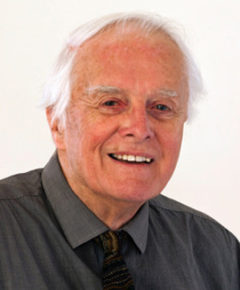The 75 x 54cm drawing has survived a journey of half way round the world and a house fire and was very generously framed by Ben for one of my numerous birthdays. It is dated 7 February 1940 – the year I started to learn all about architecture.
In 1940, at the age of 16, I inexplicably had the urge to do a measured drawing of my bicycle without having had any previous tuition or any premonition that it would prove to be a significant event in my life.
I had just been rejected as Grade 4 in my medical for joining the RAF as my R ear operation and my reliance on glasses let me down. I had just finished a year at Ferguson Pailin, circuit breaker manufacturers in Audenshaw near Manchester but becoming increasingly unhappy at having chosen electrical engineering as my career, so in effect I was still searching for a way to earn my way in the world.
The bicycle drawing was drawn in ink (in itself a challenge to a novice) on a double-elephant sheet of cartridge paper on the kitchen table (the only warm room in the house – it being early February), using a very primitive set of drawing instruments and no Tee square. It was drawn to 1/3 scale to fit onto the sheet with drawing pins in the corners.
Belatedly, I must have intuitively realised that electrical engineering was not for me (its still a mystery why) because my academic strengths at Oldham High School were art, physics, and geometry– an ideal combination for some profession requiring those basic skills (but a failure at everything else). A near neighbour’s son John Bickerdike had already started in the School of Architecture at the Manchester School of Art in September 1939 and he may have convinced me and my parents that architecture sounded appropriate to my skills
As I had already disappointed everybody by failing my School Certificate, a tertiary education for a profession was seemingly out of the question. Nevertheless, an appointment with John Holmes, Principal of the Manchester School of Art overcame that disadvantage.
I owe it to Mr Holmes that he recognised my potential and on showing him the drawing of my bicycle he said that there was no doubt I had the drawing skill and the right academic skills which were suitable for an architectural career. I was in, even though the course had started some six months earlier and I became the first in our family to be given the benefit of a tertiary education.
Mr Holmes must have recognised me as a ‘late starter’ and I have always remembered that fact and been sympathetic to those who, like me, catch up later.
Five years later (at 21) I qualified as an architect with a Distinction in my thesis on ‘Sound Insulation in Buildings’ and top marks in the Royal Institute of British Architects Final Examinations for Architecture, held in London in 1945 with over 300 candidates. That earned me my first award of the Ashpitel Prize (£20 for books, some of which I still have in my library.
Something I have never understood was the fact that the RIBA never notified me of winning the Ashpitel Prize. I learned it quite accidentally when reading a Building Construction Newsletter while working in 1946 at the Oldham Borough Surveyors office. There was a small paragraph anonymously embedded in the news items that “Derek Wrigley had won the RIBA 1945 Ashpitel Prize”
Naturally, I wrote to the RIBA about it and received an apology and a cheque for £20 – ‘an administrative oversight’.
Previous prizes I won in 1944 were from the Manchester Society of Architects – first prize for my measured drawings of the lovely Gothic Cartmel Priory (five sheets of very precise drawings which I really treasured, but lost in the fire at my Jansz Crescent house in 1974 – hence the ragged burnt edges in the photo above – the only remnant to survive).
The other prize was also with the MSA in 1944 – first prize in the Senior Design Competition – a double first. Not bad for a late starter and at last my parents had reason to be proud of my prowess.


